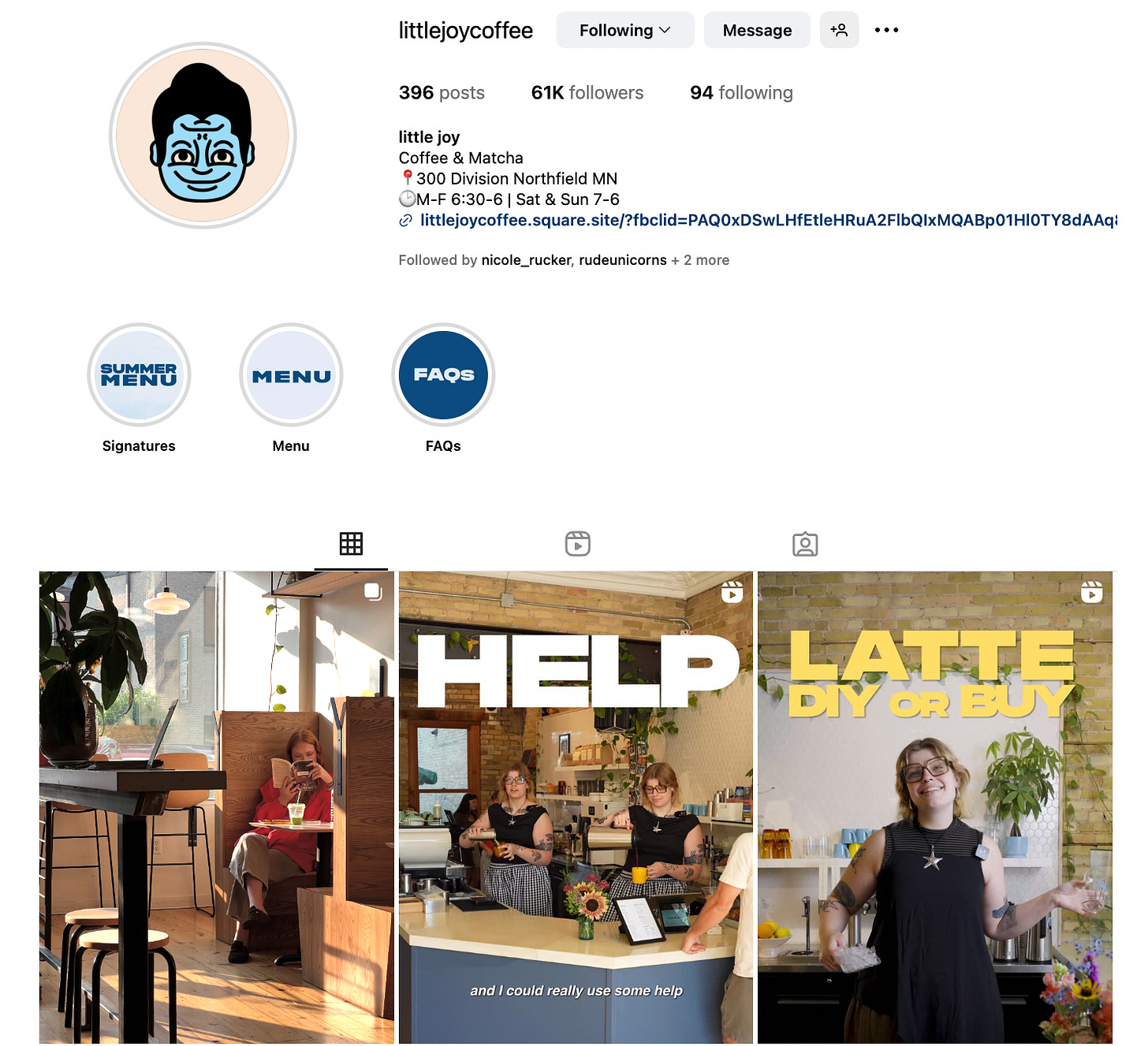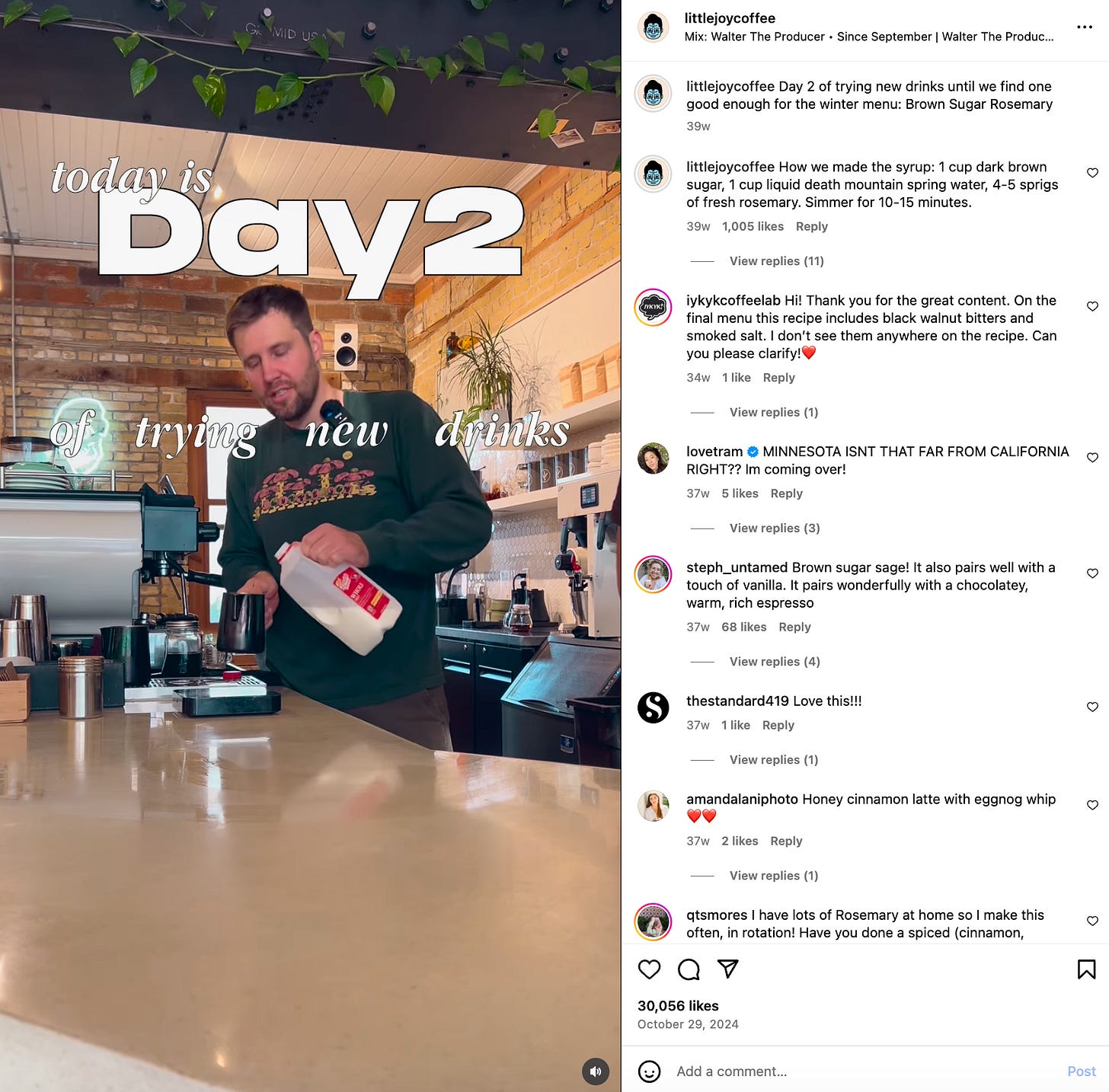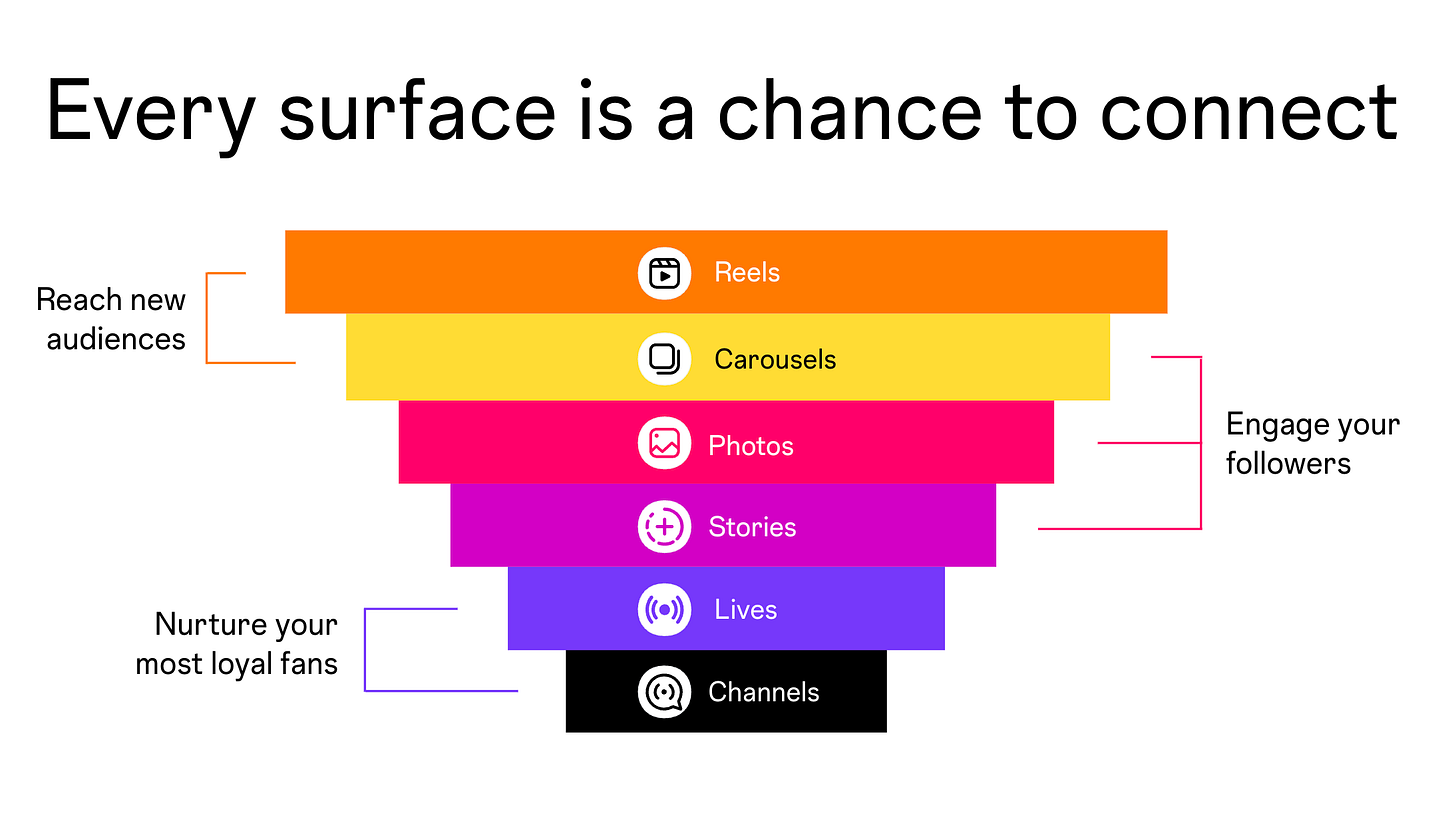Is your Instagram engagement stuck?
Try thinking of the platform like a funnel.
I do my best to maintain a level of optimism about working in social media, but there are some days where I go there. Every post looks the same. Trends “perform” but don’t build brand equity. Algorithms favor rage bait. AI is everywhere and audiences don’t seem to care. Strategies that used to work, now fall flat. All of this matters. None of this matters.
I know I’m not alone in feeling this way. In a survey from earlier this year, I asked how you were holding up. I heard things like:
When I sat down on Friday to start working on today’s usual strategy newsletter, I was in one of these funks. I wanted to write about what’s going on with Instagram engagement, but couldn’t find the words. Everything I typed sounded so…negative. I closed my laptop and went out to dinner. Maybe tomorrow I’ll feel more inspired, I told myself while ordering a martini.
Earlier that day, I had reached out to Little Joy, a small coffee shop in Northfield, Minnesota that has built a dedicated following through focused series like “Day __ of trying new drinks until we find one good enough for the winter menu” and “Latte DIY or buy”. I had a few questions about their strategy that I planned to publish in an upcoming newsletter.
I was mid-shrimp scampi bite when the answers came through. A quick scan turned into a close read. Points that were taking me hours to (unsuccessfully) articulate that afternoon, were laid out so clearly by owner of the shop Cody Larson. Like how episodic content builds audience trust, the business impact of social media (their revenue is up 40% YoY), and why coming up with a “show” helps avoid content creation burnout.
When social media starts to feel complicated or frustrating, the answers can be simple. For Little Joy, one original series changed the entire trajectory of their account and, ultimately, their business. That’s it. No trending sounds, rage bait, or AI-generated images. It was the reminder I needed to get out of my rut. Here’s what’s inside today’s newsletter:
My interview with Little Joy
Understanding the new Instagram funnel
What to do when your engagement feels stuck
“The algorithm seems to value episodic content 10x over one-off videos”
Rachel Karten: Hi! Thanks so much for taking the time to chat. Can you start by telling me about the team who works on Little Joy’s social?
Cody Larson: We get asked a lot if we have a professional marketing team, or we’ll get comments like “marketing manager deserves a raise” and I’m like cool, but it’s just me and the barista doing it all.
I’m Cody, the owner, and I film, edit, and occasionally appear in a video. I’m far from a professional, but I do have a background in creative writing and literature, so I think that helps when coming up with concepts and deciding how to structure the videos.
Serena, our shop manager, and star of most of our videos, is naturally so funny it’s not even fair. She’s gen z and had a Harry Potter YouTube fan channel as an adolescent so she’s really comfortable and 100% herself in front of the camera, which I think is a big part of what makes these videos work. We’ll sometimes have some bullet points but there’s never a script.
RK: I scrolled back and it looks like a big shift happened in views back in October 2024. It was around when you launched "Day __ of trying new drinks until we find one good enough for the winter menu". Can you talk about that initial viral video and how it impacted your social strategy moving forward?
CL: What I learned from our first viral video is that when something is working for you on social media you need to dissect it, figure it out, and do more of it. A lot more. And move fast!
So a little background, we had been making videos since Reels first came out. And I was putting in a good amount of effort, getting like 6K views tops. Which I was totally fine with. Then we posted this video—with very little effort put into it—and in a few hours it’s doing better than anything we’ve ever posted. The next day it’s like triple the views of anything we’ve done before. So that makes you kind of stop and say, “ok, what about this is resonating with people?” and more importantly, “how can I make more of these and get them up like yesterday.”
So the next day, we film another video. This time I add an intro: “This is day 2 of trying new drinks until we find one good enough for the winter menu.” It gets like half a million views in three days. At that point, we had a formula that was clearly working so we stuck to it. We ended up making 13 episodes in 30 days, gaining 40K followers with several million views across the series.
RK: I appreciate how focused your videos are—most fit neatly within a recurring series. How has creating those clear formats helped grow your audience?
CL: I have three little nuggets of wisdom to share for this one:
The algorithm seems to value episodic content 10x over one-off videos. I don’t know if this is written in the code or it’s based on viewers engagement. But I can tell you exactly why I think this. Going back to our Winter Menu series, imagine now you’re me and you just clicked post on episode five, for example. The notifications start rolling in. Within a few minutes you have thousands of likes and hundreds of follows. You would expect that all these new notifications are coming from the video you just posted, right? Wrong. You click the notifications tab and realize everyone is liking and following from episodes one and two. I don’t know how, but the algorithm knows you just posted a new episode and it brings in new viewers, not to the video you just posted, but it starts them at the beginning of the series. Where they can then binge all the current episodes and it leads to lots of follows.
Creating episodic content that follows a consistent formula is like saying to the viewer, “hey, if you follow us, we’re going to show you more videos just like this one.” It builds trust. You can amplify this effect by promising a resolution at the end of the series. Which is like saying, “hey, Viewer, if you follow us, not only are we going to show you more of these videos that you like, but something cool will happen at the end.” I don’t like to use the word “hack” but I’m going to use it here. If you’re looking for a growth hack for social media, try coming up with a series that promises some sort of pay-off at the end. Like Ryan Trahan getting a penny across the United States. Or a coffee shop trying new drinks until they find one for their winter menu. People want to know there will be a pay off.
Lastly, having a clear formula has helped us grow because we can make more videos and make them faster. Decision fatigue is huge for me. I know I can only make so many decisions a day before I’m cooked. And my editing process reflects this. Once I’ve dialed in on a structure for a video, I save that video as a template in my editing software and I literally overlay the shots for the new video frame-for-frame over the template. As someone who will edit endlessly until I burn myself out, it’s been extremely helpful having this kind of structure, not just for growth, but for my own sanity.
RK: Have the viral videos led to more business and foot traffic?
CL: 100%. Year-over-year revenue is up 40%. And being in a town with two colleges, we were busy before going viral. We’ve added another shift to the day and have been able to give raises to the staff as well. If anyone knows a good spot for a second location lmk!
RK: What advice would you give to a local business that is trying to find success on social media?
CL: Social media is replacing television. And just like in television, there’s the shows you tune-in to watch and there’s the commercials you suffer through. Stop making commercials. Be the show.
The new Instagram funnel
In order to understand why series on social are working, it’s important to understand the Instagram funnel.
On Old Instagram, brands told lots of stories across their feed. They’d entertain and convert and educate and update. Most posts—no matter the format—would get shown to the brand’s followers. It was generally understood that as a brand’s following grew, so would their engagement.
For the past few years, Instagram has been transitioning to an algorithm that prioritizes discovery over community. This is New Instagram. They reward accounts for posting shareable videos that resonate with followers and non-followers. Instead of people who are already bought into a brand determining the engagement destiny, it’s people who are potentially interacting with the brand for the first time. This inherently changes the type content that “works”. How do you get a stranger to care?
On Link in Bio’s call with Instagram, the team shared the below funnel. It’s the first time I had seen Instagram’s surfaces articulated this way. Notably, Reels and Carousels are considered top-of-funnel surfaces to “reach new audiences”. These are a brand’s growth levers.
The Instagram team also shared that each part of Instagram uses its own algorithm. That means there is an entirely different algorithm determining the reach of a Reel versus a Photo. There are three important signals that the Reels algorithm uses: watch time, the rate of shares, and the rate of likes. Instagram then also looks at a user’s previous activity to determine if they might enjoy a video from your brand. It takes into account Reels that they’ve liked, saved, shared, commented on, and watched all the way through.
Here’s where serialized content comes in. If one of your Reels gets a lot of engagement, the posts around it become equally important. The Reels algorithm will start showing additional content from your brand to viewers once they engage with one of your posts—whether they follow you or not. If that next Reel doesn’t feel within the same world as the first one, the user likely won’t engage or signal that they want to watch more content from your brand. You’ll fall out of their scroll.
When your brand creates a focused vision or series for Reels, that’s where the magic is. You’ve set clear expectations for the viewer. They’ll stick around. They’ll watch your show.
What to do if you feel stuck
Ask yourself, “If our brand could do one video series really well, what would it be?” Hold a big brainstorm. Come up with ideas. Have fun with it. What’s our “set”? Who are our main characters? Where’s the tension? Does our series need to also have the flexibility to layer in products or announcements? Should we start a new account for it?
Look at other brands that do this well. Importantly, a series doesn’t need to be labeled as such—think about it as video content that all fits within a specific world. It can be a episode-based like Little Joy, format-based like Craighill, vignette-based like GANT, location-based like Ritz Paris, or employee-based like Onda Pasta Bar.
Study creators. Craighill mentioned Colin and Samir when I interviewed them and Little Joy just mentioned Ryan Trahan. It’s not a coincidence that two accounts having lots of Reels success are studying creators and YouTubers.
Commit to testing the series. For the next 30 days, only post videos that fit within the guardrails you’ve set—even if it’s only once or twice a week. Stop throwing spaghetti at a wall and instead do one thing really well. Put effort into the series. Study the performance. Understand why one “episode” popped and another didn’t. Tweak and tinker.
Check in and report back on the series. How did it feel not worrying about trends? Did views increase? What about followers? Was it easier to plan content?
Keep it going, create a new series, or ditch it altogether. It was one month. You would have never known if you didn’t try!
A few quick links
Columbia Sportswear wiped their grid and announced their new campaign “Because Mother Nature can be a real Mother f-”. Really good.
Head of Instagram Adam Mosseri said in a recent AMA that accounts that use Edits get a slight algorithmic benefit. When I asked the Instagram team about this, they told me, “Adam noted that accounts using Edits may receive a slight algorithmic bump. This is accurate and something we recently introduced, but the boost is modest and temporary. We encourage creators to try Edits as a feature to improve their content, but they should not rely on Edits as a strategy to increase reach over the long term.”
The account NBA Research & Development Department isn’t run by the NBA but it it would be cool if it was. Good example of the algorithmic benefit of a series!
I love that COQODAQ created a skit to announce their very popular nuggets will be at the 2025 US Open for everyone, not just at the club level. They could have easily done a photo of it with simple text, but the creativity of this video made me want to watch more of their content.
Museums have been sharing very funny videos with this horse song. The Getty, Fenimore, and Worcester have all made their own versions.
This carousel from Surreal overperformed and received over 52K likes. It’s really fun to swipe through.
The Gap x BÉIS rollout has been stellar. I thought the announcement video was great.
Happy Corpse Flower season to all who celebrate! Highly recommend following The Huntington.
I want to shout out Alex who runs social for the Minnesota Orchestra. She’s the one who shared Little Joy’s account in the Link in Bio Discord a few weeks back and inspired this interview!
Finally, if you made it this far, it means you’re a paid subscriber and get access to the Link in Bio Discord. You can join here.









I’ve been talking about how social media is now everyone’s TV and reading that quote about it here made my brain explode. (Be the show!) That and this funnel made me a paid subscriber. Thank you for the great work!
I am obsessed with your content. It is so informative and a joy to read. Embarrassing that I even questioned the $8 monthly investment ;) I look forward to all of your articles.